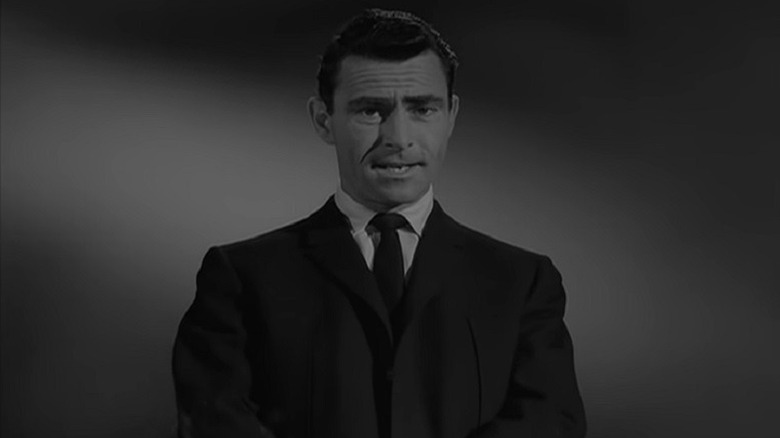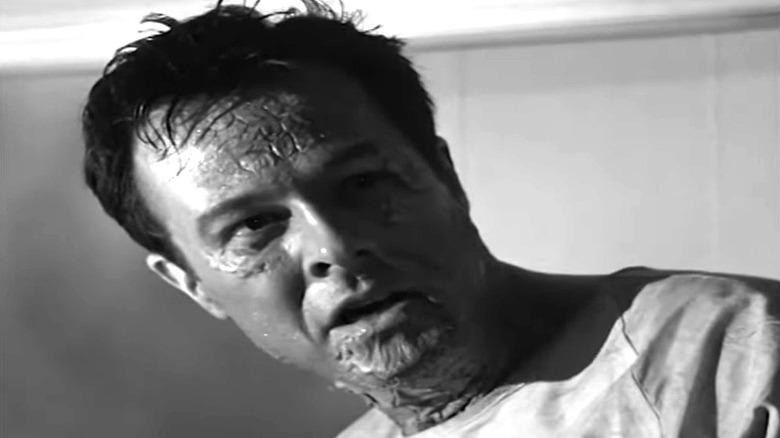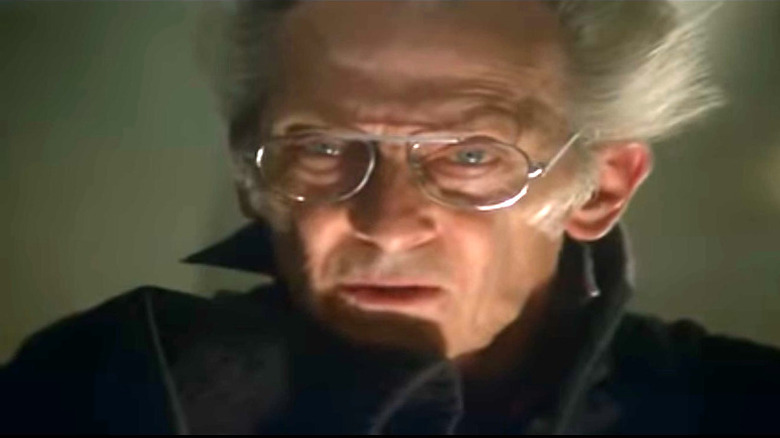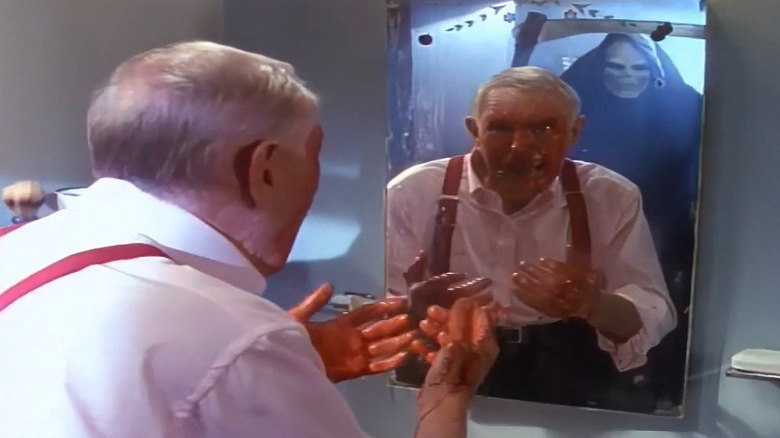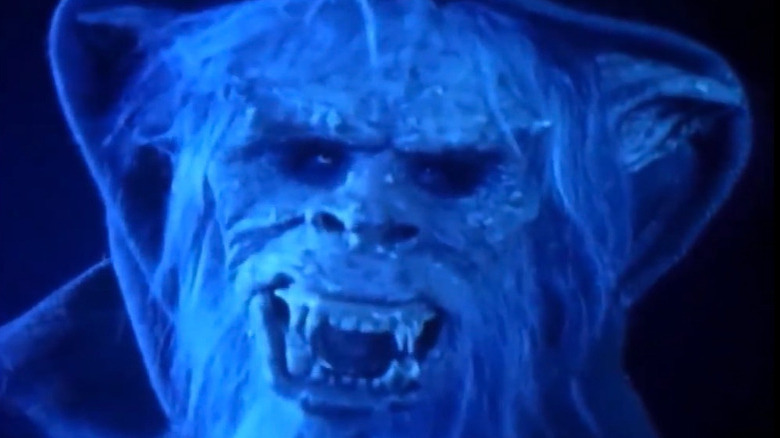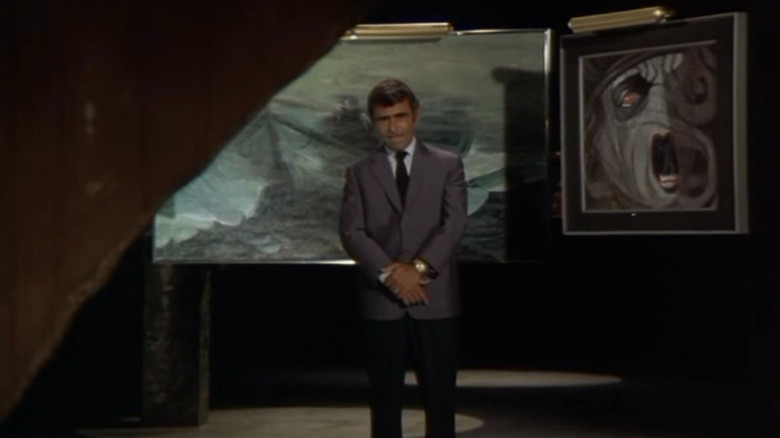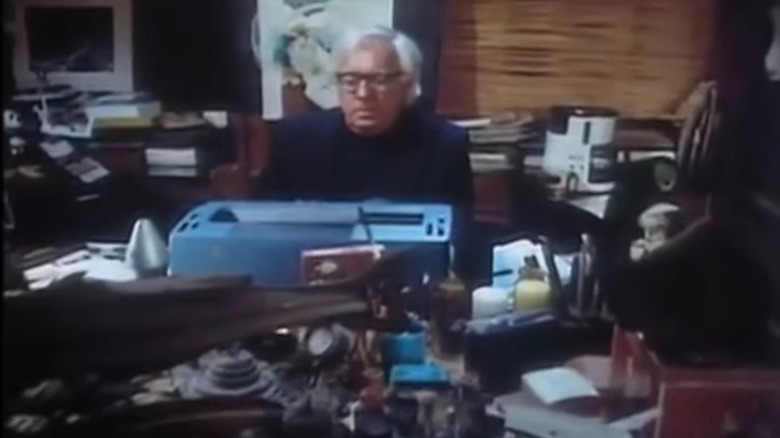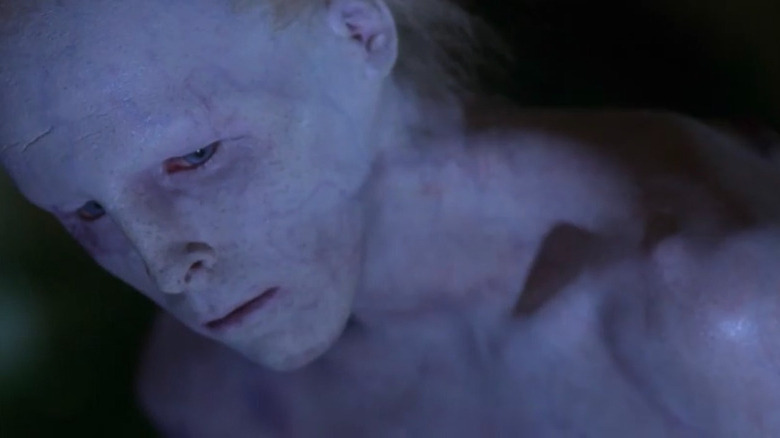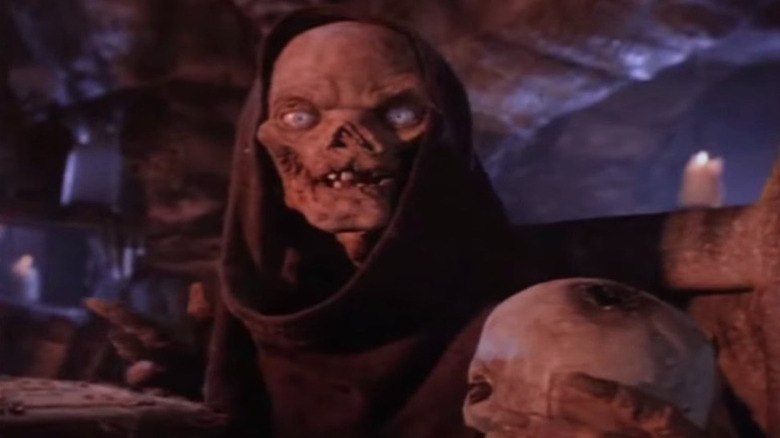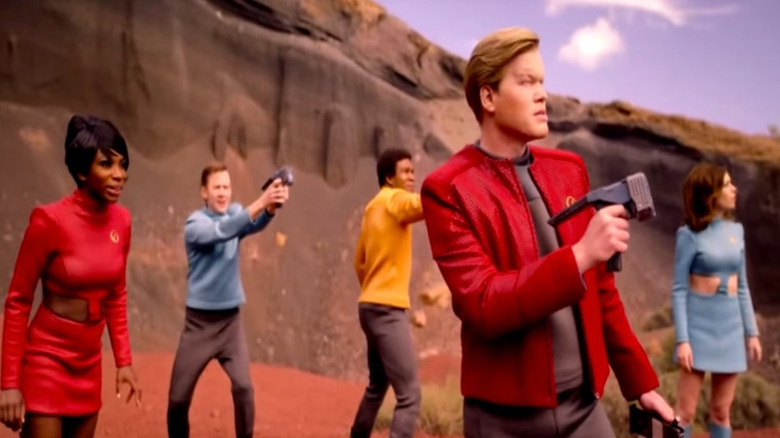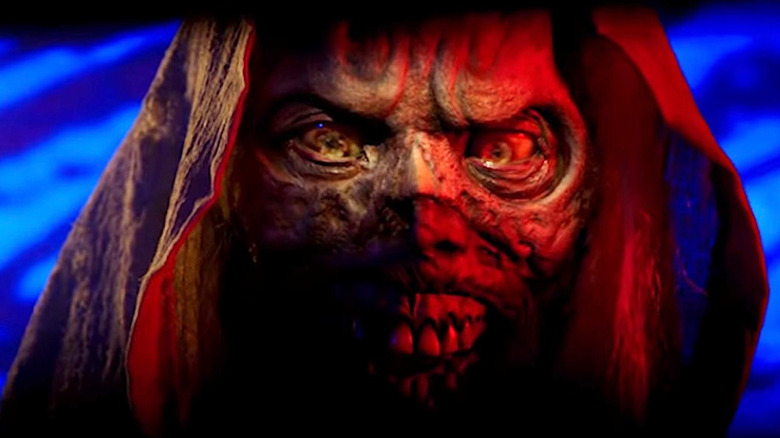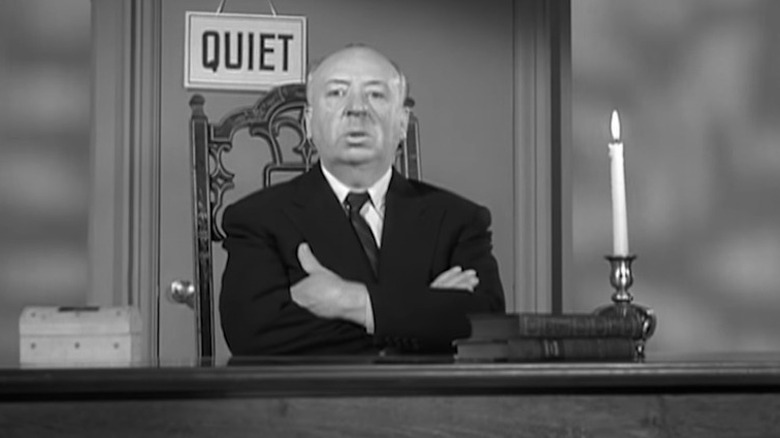12 Anthology Shows Like Guillermo Del Toro's Cabinet Of Curiosities Fans Should Check Out
Beginning with the vampire film "Cronos" in 1993, director Guillermo del Toro has established himself as a storyteller with a massive vision and the talent to back it up. Each one of his movies, from "Blade II" to the Oscar-winning "The Shape of Water," has pushed the visual envelope in some way. He's taken the beautiful and fantastic and merged them so effectively with the grotesque and macabre that these elements have become indistinguishable.
That was also the goal of his Netflix anthology series "Guillermo del Toro's Cabinet of Curiosities," whose trailer features del Toro plainly stating his intention. "With 'Cabinet of Curiosities,'" the director says, "What I'm trying to do is say, 'Look, the world is beautiful and horrible at exactly the same time.'" That's a healthy, balanced, worldview that's represented in all of his work.
If you find yourself wanting to watch other anthology shows that blend the fantastic and the mundane, then we've got you covered. Below is a list of anthologies that all, in some way, reflect the very ethos del Toro has adapted for his series. Not every anthology focuses exclusively on horror (though many of them do), but every one explores the world in its own uniquely twisted and fascinating ways.
The Twilight Zone
Rod Serling's "The Twilight Zone" didn't invent anthology television (it was already a popular format), but it just about perfected it. There's a very good reason this show remains at the forefront of public consciousness — it's brilliant. Not every episode is a masterpiece, but enough of them are that the show has gone on to influence storytellers to this very day.
Each episode is a standalone story dealing with some aspect of the fantastic. Sometimes that means classic science fiction with rocket ships, aliens, and robots. Other times, it's dark fantasy, with fortune-telling machines in a diner that accurately predict future events or a child capable of controlling reality with his mind. Then there are sweeter episodes where men travel back in time to their childhood home just by taking a walk or a town that only reveals itself to travelers in desperate need of it.
These are excellent stories about the human heart told and performed incredibly well. There's a timelessness to their themes and to the production that makes them feel relevant, over half a century later. There have been three separate reboots of the series (they come along about every 20 years), and they all have their pluses and minuses, but the original 1959 series remains the gold standard.
The Outer Limits
Science fiction may not be the first genre that comes to mind when considering Guillermo del Toro's work, but he takes such a tactile approach to his creation of the impossible that several scenes discussing the anatomy of his creatures might as well have come from classic B-movies. And that's exactly what the original version of "The Outer Limits" was. A black-and-white series from the early '60s, "The Outer Limits" was essentially a collection of 1-hour sci-fi monster movies with budgets too low to support their concepts but stories that won out over their limitations.
The series may not be spoken about as often as "The Twilight Zone," but it's proven to be incredibly influential in its own right. The episode "The Architects of Fear" is so similar to "Watchmen" that both Alan Moore's comic and Zack Snyder's film feature direct references to it. Two Harlan Ellison scripts "Demon with a Glass Hand" and "Soldier" feature time travelers from future wars sent back to the past and were so similar to James Cameron's "The Terminator" (especially the opening of "Soldier") that the director was forced to acknowledge Harlan Ellison in the credits to the film. When a show has this much influence on the genre, you know it's worth checking out.
Hammer House of Horror
Hammer films brought back the classic monsters in vibrant and violent colors during the '50s, '60s, and '70s. With their emphasis on blood and sex, they were able to shake the dust off of old gothic horror settings and make them new again to an audience that had become bored with Boris Karloff and Bela Lugosi. The studio so successfully reinvented the genre that Christopher Lee and Peter Cushing were considered equally iconic as their forebears from the '30s and '40s.
The 1980 series from UK network ITV "Hammer House of Horror" sought to translate that formula to television. With just 12 episodes, the studio was able to tell dark, violent, and perverse stories that almost lived up to their silver screen counterparts. Instead of having a massive canvas on which to slather with red, they had to shift their focus to the small screen by making their stories more intimate and modernized.
Most of these stories don't take place in grimy old castles or dusty laboratories — they're everyday homes lived in by the audience watching it. By bringing the terrors of the old world to the present and familiar one, the show was able to connect on a psychological level that wasn't there with the films. If you were a fan of del Toro's "Crimson Peak," then chances are you're well suited to the work of Hammer Films.
Monsters
You can't talk about anything related to Guillermo del Toro without mentioning his love of monsters. Not only has he openly discussed his interest but just watching his movies (and television shows) makes it obvious that this is an artist obsessed with monsters. They're usually the protagonist, more interesting than the human characters, and sometimes the object of romantic fascination. Therefore, it only makes sense that if you're going to watch something that reminds you of his work, you need to check out "Monsters."
Something of a spiritual successor to "Tales from the Darkside" (both shows share a producer in Richard P. Rubinstein), "Monsters" deals with humanity interacting with beings and entities beyond our understanding. The eponymous monsters can be of the manmade variety, twists on old legends, or classic depictions modernized for the 20th century. The tone ranges from satirical to goofy to surreal and horrific.
For whatever reason, anthology shows had a bit of a renaissance in the '80s, but apparently, nobody wanted to give them adequate budgets. So, to enjoy them — "Monsters" in particular — you'll need to look past their horrific production value. If you can do that, though, then you'll find yourself having a blast with this fun and often ridiculous series.
Tales from the Darkside
Two years before Steven Spielberg came to television with his whimsical anthology series "Amazing Stories" and six before HBO struck gold with "Tales from the Crypt," indie film trailblazer George A. Romero took us to the dark side. His syndicated series "Tales from the Darkside" should be unwatchable. It's cheap, and the intro is bizarre and corny, but it all works really well.
This is a criminally underrated series that tells bold and daring stories that range from pure funhouse entertainment to shockingly sharp satire and devastatingly bleak horror. Romero is a director who's always been ambitious, with a reach that exceeds far beyond his grasp. That is why so many of his movies transcend their equally low-budget peers: He has a worldview he attempts to communicate through his work, and that permeates every episode of "Darkside."
He wasn't alone, however. The series featured stories and scripts from some serious heavy-hitters in the genre like Stephen King ("Sorry, Right Number," the tale of a creepy phone call), Harlan Ellison ("Djinn, No Chaser," where genie terrorizes a couple), and Clive Barker ("The Yattering and Jack," where a demon tries to corrupt a friendly salesman). This is a series best viewed late at night, just as drowsiness sets in and you're especially open to fiction's particular power of suggestion.
Night Gallery
Despite it coming from Rod Serling, "Night Gallery" is not as good as 'Twilight Zone." There are a few reasons for that. The first is aesthetics. Unlike the timeless look of its predecessor, "Night Galley" is firmly rooted in the decade it was produced. Hairstyles, clothing, set design — all of it is excruciatingly '70s, making it feel somehow older than the series that preceded it by 10 years. The other is format. Instead of one story per episode, there were usually at least two. This means there isn't enough time to connect with the story you've just seen before moving on to the next. Lastly, there was studio meddling. Serling didn't have the same authorial control over the series.
All that aside, it's a solid work of gothic horror. Not every story is a moral masterpiece meant to question human nature. Most of them are atmospheric experiments in the macabre that weave a subtle spell around the viewer, bringing them into a dark world and attempting to show them something they've never seen before. Of course, it isn't always successful in this, but the attempt is appreciated. When done right — like the pilot episode "Eyes" directed by Steven Spielberg and starring Joan Crawford, which tells the tale of an eye transplant gone very wrong, or "The Caterpillar," involving an earworm that lives up to its name — these can be haunting stories that linger in the back of your mind, waiting until the lights go out to remind you of their presence.
The Ray Bradbury Theater
Ray Bradbury was such a prolific writer it's a shame he's primarily remembered for "The Martian Chronicles" and "Fahrenheit 451." Those novels are undisputed masterpieces and crucial to the development of the sci-fi genre, but they only represent a fraction of the man's unparalleled imagination. He wrote everything you can imagine: terrifying horror stories, gripping mysteries, heartbreaking memoirs, and even pieces of absurd comedy. To him, anything and everything could and should be a story so he wrote about any idea that popped into his mind, and he did it brilliantly.
However, his lyrical style can be difficult to adapt. Thankfully, the man himself took up the task with the anthology series "The Ray Bradbury Theater." The intro to the series tells you everything you need to know: This show is Ray Bradbury's head put on paper. He surrounds himself with inspiration, lets it work its way into his skin, and takes off on an incredible journey. There are episodes of this show that are deeply creepy (like the one where a mysterious crowd keeps showing up at car crashes) and others that are sweet and thoughtful (like the one where a man returns to the lake where he lost his childhood friend). Some seem impossible while others are so grounded they make you quiver with the realization that this could happen to you. There are budgetary issues, of course, but the thrill of experiencing Bradbury's imagination more than makes up for it.
Masters of Horror
"Masters of Horror" is definitely a concept that a cinephile like Guillermo del Toro can get behind. Legendary directors in the horror field like John Carpenter, Dario Argento, and Don Coscarelli were allowed to make new films (each about an hour in length) without worrying about being censored by a studio. For the first time since their independent days, they were able to let their creative sails loose and see where it would take them.
Some of the episodes are incredible. "Cigarette Burns" is perhaps the darkest, meanest, and most disturbing film John Carpenter has made since "Prince of Darkness." The image of a trapped angel whose wings have been severed from its body feels like something right out of a del Toro film. "Homecoming" — with a bunch of zombie soldiers — is Joe Dante doing some of his best satire. And "Imprint" by Takashi Miike is considered to be a genuinely disturbing piece of torture cinema right up there with "Audition."
There are other stories that don't work as well and some that a perfectly serviceable. As is the case with any anthology, there's bound to be something you don't enjoy. That's okay, though, because next episode, there'll be another chance to find a story you love.
Tales from the Crypt
Before HBO became a major player in the original content game with huge hits like "Game of Thrones," it was willing to give anything a try that might bring in viewers. This included allowing Hollywood mega-producers Richard Donner (director of "Superman," "Lethal Weapon," and "The Goonies"), Robert Zemeckis (director of "Back to the Future," "Forest Gump," and "Cast Away), and Joel Silver (producer of "Die Hard," "Predator," and "The Matrix,") indulge in their love for the gory, sleazy EC Comics of their youth by creating the superb anthology series "Tales from the Crypt."
Widely remembered for its ghoulish host, the Cryptkeeper, each episode has its own tone and unique take on the material, but the structure is almost always the same: Someone does something unforgivable, and they get punished. Within that structure is the freedom to tell character pieces, over-the-top revenge stories, hilarious and twisted stories about infidelity, or even science fiction. With massive talent working behind the scenes and no fear in terms of content, the series was a hit for seven years. It also spawned a kid-friendly animated series called "Tales from the Cryptkeeper" and two movies. This groundbreaking series has been hard to find anywhere other than DVD and desperately deserves a return to our screens.
Black Mirror
Although a number of other shows have tried and failed to live up to "The Twilight Zone," "Black Mirror" gets about as close as possible to doing a modern-day "Twilight Zone" correctly. It's the only anthology show with the guts to tell hard-hitting, moral stories that ask disturbing questions of the viewer in a way that makes them consider the implications for weeks and months. We can joke about how "crazy" or "wild" some of the plots are, but all of them make us think.
The series truly is a dark mirror held up to the audience, presenting them with an unflattering reflection they'd like to turn away from but are incapable of doing so. Episodes like "White Bear" dissects the detachment with which we view the world through our phones. "15 Million Merits" sears the public's obsession with "reality" television and the sacrifices too many of us are willing to make in order to become famous. "USS Callister" is a metaphor for toxic fan culture, taking out their real-life grudges in the virtual realm.
Then there are hopeful stories like "San Junipero" that offer the optimistic side of technologies ability to bring people together. This is modern-day anthology television at its very best, and the series is bound to inspire storytellers for generations to come.
Creepshow
Based on the 1982 George A. Romero and Stephen King film "Creepshow" (and its 1987 sequel), the Shudder original "Creepshow" is a fantastic throwback to the horror anthologies of the '80s. Relying more on practical effects, there's a tactile weight and physicality to the horror that sticks with you longer than almost anything CGI can cook up. Still fairly low-budget, the series does an excellent job of glossing over those shortcomings with fun scene transitions designed to resemble a horror comic.
The stories here aren't lofty attempts at peering into a human soul to see how far it can bend before breaking. These are straightforward spooky tales meant to entertain, complete with a creepy dollhouse, a man in a suitcase, and the Necronomicon itself. Even though the obvious influence here is EC Comics and horror television of the '80s, there's a timeless sensibility to the simplicity of each story. Every one of these episodes (even the sillier ones) feel as though they were adapted from classic works of horror (which, some of them were). It doesn't have the same spark of unbridled creativity as "Tales from the Crypt," but it's the closest we've seen in quite some time.
Alfred Hitchcock Presents
Few filmmakers are as synonymous with suspense as Alfred Hitchcock. This is a man who spent an entire career perfecting the art of audience manipulation. From his early silent work to his colorful and less controlled pictures of the '70s, Hitchcock continued to push boundaries and wrap viewers around his finger until his death. Whether he wanted you to feel overwhelming dread with "Psycho," thrill you with "North by Northwest," or disorient you with "Vertigo," Hitch knew exactly how to make you dance to his dark symphonies. Even Guillermo Del Tor is a huge fan.
The television series "Alfred Hitchcock Presents" sets out to do the same thing on the small screen. Instead of running out to the movie theater to see the latest masterwork, fans could stay and home and grip the sides of their favorite chair for comfort. These were short suspense stories about murder, secrets, and betrayal that usually kept you guessing to the last minute. One tells the story of a paralyzed businessman mistaken for dead, another about a killer with a corpse in his trunk and a cop out his window, another about a man trapped in a room with a deadly snake. Each story features an intro and outro provided by the man himself, usually with some dry witticism about the play to ease you in and out of the plot, making him a welcome guest in your living room.

